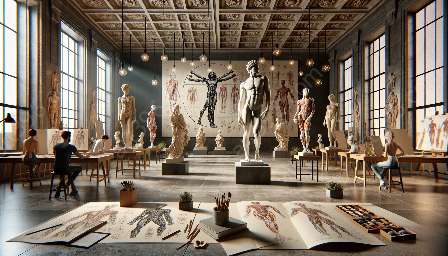When it comes to art, the use of negative space in relation to body poses plays a significant role in creating captivating compositions. In this comprehensive article, we'll delve into the concept of negative space and its compatibility with composition and artistic anatomy, providing insights for artists and enthusiasts alike.
Understanding Negative Space
In the realm of art, negative space refers to the empty or unoccupied spaces around and between the subjects of an image. It is the space that surrounds the primary subjects and forms an integral part of the overall composition. While negative space itself may be empty, it holds immense visual significance in defining the relationship between elements within the artwork.
When it comes to body poses, the strategic use of negative space can accentuate the form of the human body, drawing attention to specific lines, shapes, and gestures. By artfully manipulating negative space, artists can emphasize the physical and emotional dynamics of body poses, creating compelling visual narratives.
Compatibility with Composition and Artistic Anatomy
One of the most intriguing aspects of negative space in relation to body poses is its seamless compatibility with composition and artistic anatomy. Composition in art refers to the arrangement of visual elements within a work, and the use of negative space can drastically influence the overall balance and harmony of the composition.
When skillfully integrated, negative space contributes to the overall rhythm and flow of a composition, guiding the viewer's gaze and conveying a sense of movement and energy. Moreover, it allows for the effective placement of body poses within the frame, enhancing the visual impact of the artwork.
Artistic anatomy, on the other hand, encompasses the study of the structure and form of the human body in art. Understanding the underlying anatomical principles is crucial for accurately representing body poses. The use of negative space can aid in defining the three-dimensional structure of the human body, adding depth and realism to artistic depictions.
Interplay of Form and Space
The interplay of form and space lies at the heart of the use of negative space in relation to body poses. By carefully considering the spatial relationships between the subject and the surrounding negative space, artists can create visually engaging compositions that celebrate the beauty of the human form.
Through skillful manipulation of negative space, artists can evoke a sense of balance, tension, or movement within their works, inviting viewers to contemplate the interplay of positive and negative elements. Additionally, the judicious use of negative space can evoke an emotional response, adding depth and intrigue to the portrayal of body poses.
Incorporating Negative Space in Artistic Practice
For artists seeking to harness the potential of negative space in relation to body poses, there are various techniques to explore. Deliberate consideration of the spatial relationships, experimentation with cropping and framing, and mindful use of light and shadow can all contribute to the effective utilization of negative space within artistic compositions.
Furthermore, studying the works of renowned artists who have mastered the art of incorporating negative space into their depictions of body poses can offer valuable insights and inspiration. Engaging in life drawing sessions and exploring different perspectives and viewpoints can also enhance an artist's understanding of the interplay between form, space, and body poses.
In Conclusion
The use of negative space in relation to body poses presents a rich and captivating realm for artistic exploration. By understanding its compatibility with composition and artistic anatomy, artists can elevate their work to new heights, infusing their creations with a profound sense of visual depth and storytelling. Embracing the interplay of form and space, and incorporating negative space into artistic practice, opens up a world of creative possibilities, promising immersive and evocative artworks that resonate with viewers on a profound level.

